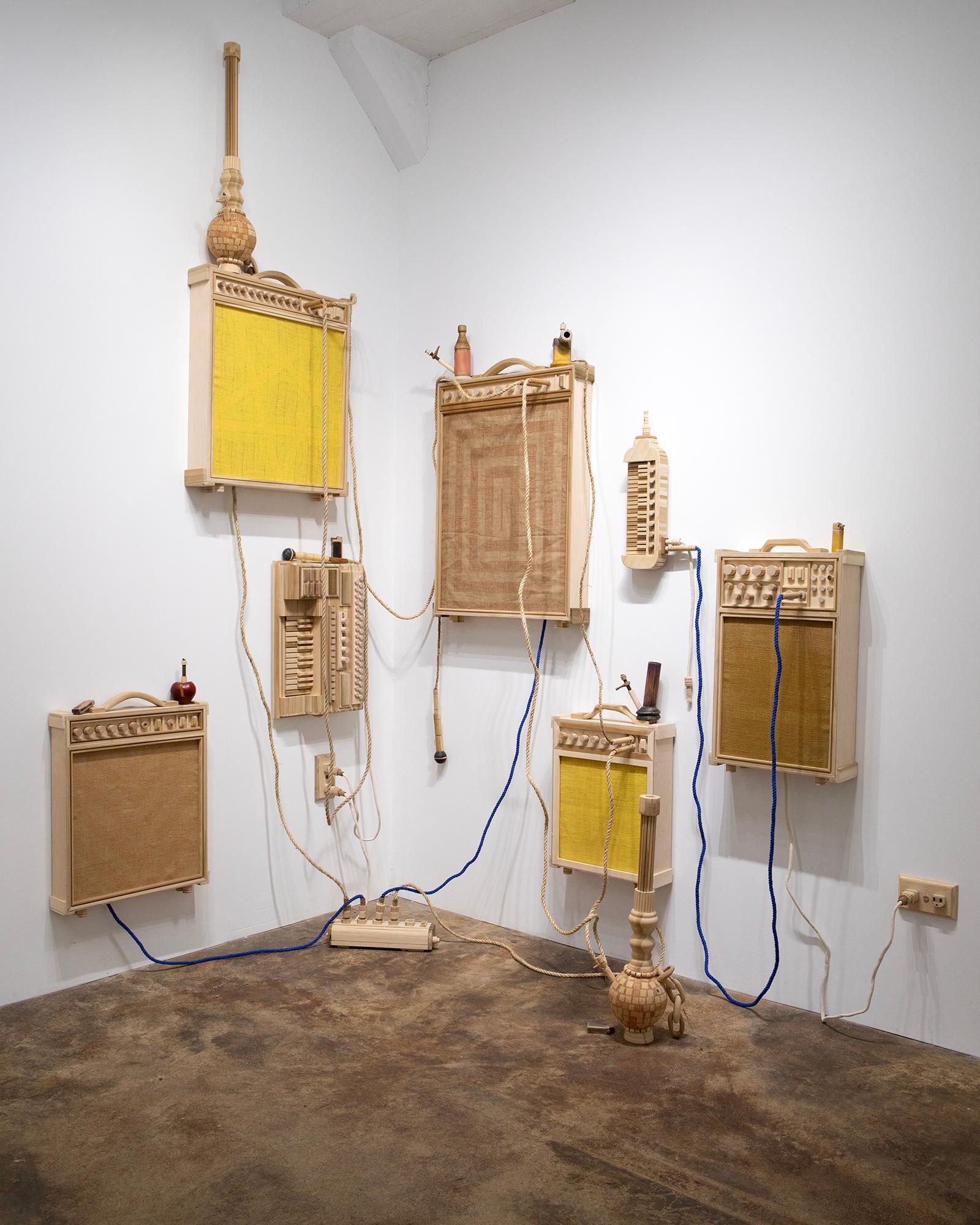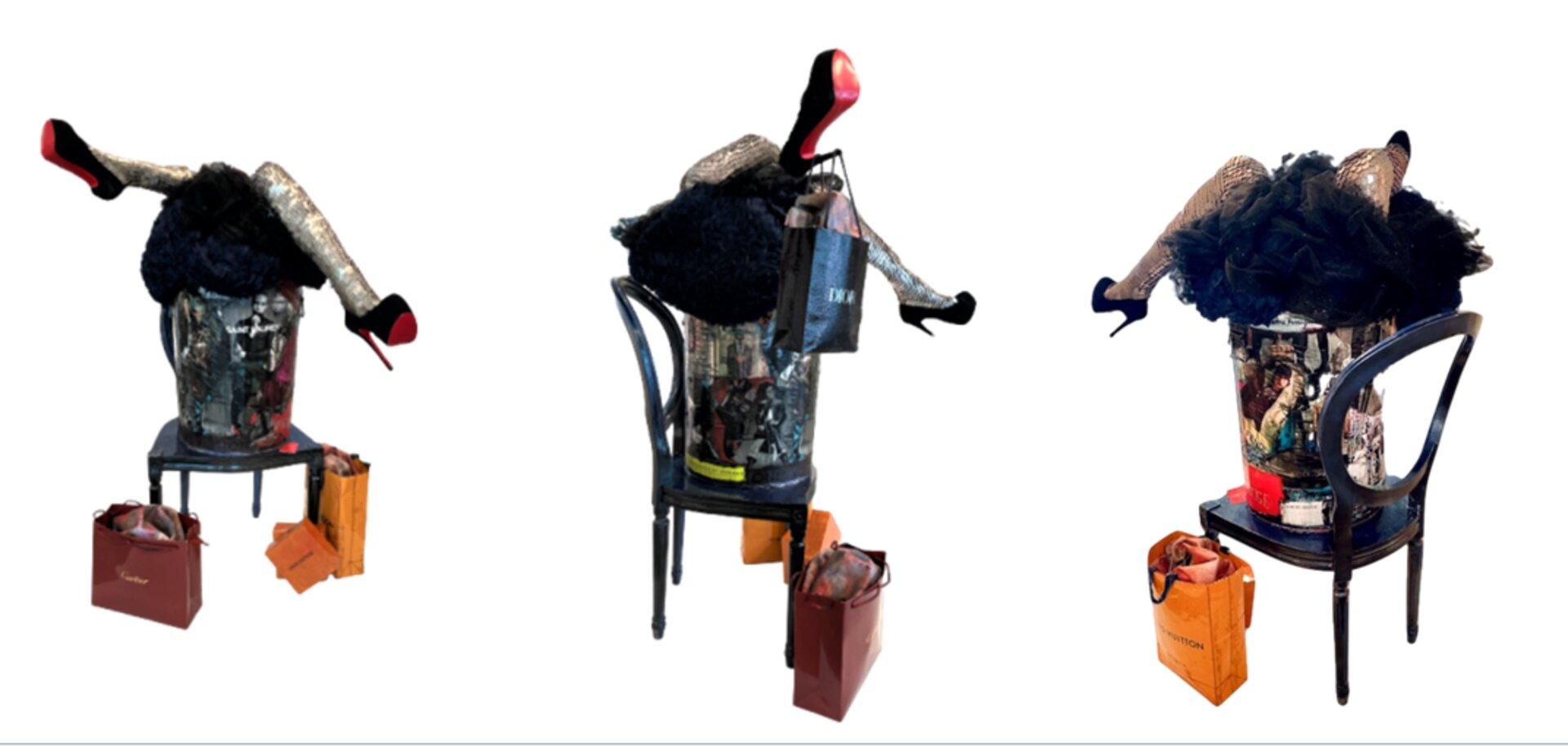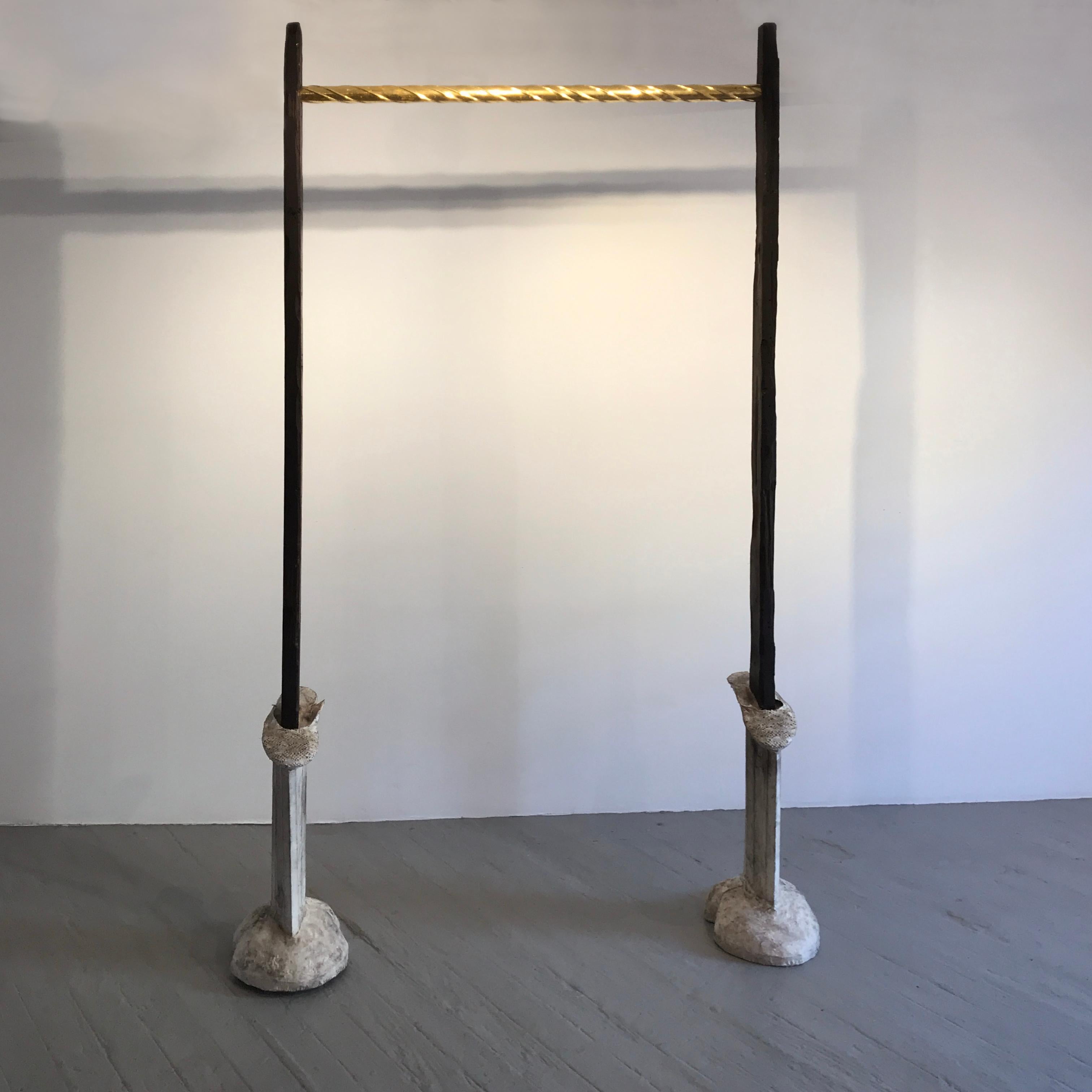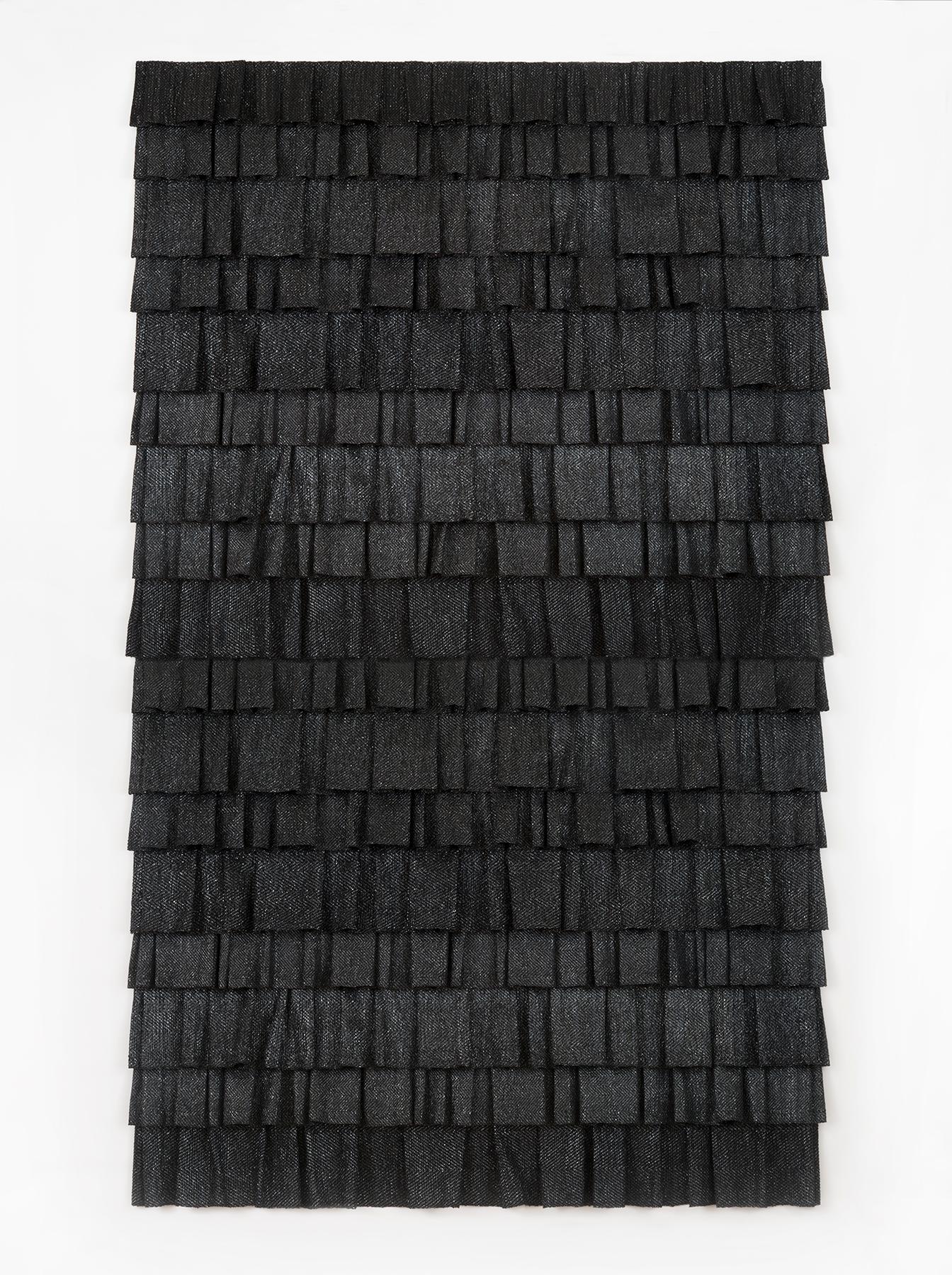Items Similar to "Golek Puppet (Male), " Wood & Cloth created by Indonesia circa 1900
Want more images or videos?
Request additional images or videos from the seller
1 of 6
Unknown"Golek Puppet (Male), " Wood & Cloth created by Indonesia circa 1900circa 1900
circa 1900
About the Item
This Golek puppet was made by an unknown Indonesian artist using wood and cloth. It is approximately 26" tall.
Traditional Wayang Golek plays can be compared to European and North America: most performances revolve around Kings, Queens, Princes and Princesses who fight against evil, mystical, beings to (usually) end happily.
Three-dimensional Indonesian puppets are carved out of light, soft wood. The head of the puppet is the most important part, and that is the most intricately carved section of each puppet. The puppeteer will often carve the face of a bird into the back of the puppet's headdress.Once the head is carved, the waist and torso are then carved.After the head and torso have been created, a hole is drilled from the neck to the bottom of the trunk where a large wooden rod is placedThe head is then mounted on the top of the wooden rodThe arms are then carved into two sections: shoulder to elbow, and hand to elbow
Wayang Golek performances take place on special events: weddings, religious ceremonies or cultural days. Performances usually begin at 9:30pm and last until 4:30am in the morning. A puppet troupe may be hired by an individual, a family or an entire village for a particular special day. A puppet troupe can consist of up to 30 people who are all directed by the dalang.
The dalang is the puppet master that organizes the entire troupe: he is referred to as a master musician, an epic storyteller, a comic wonder and even a deep philosopher. Some dalangs even have the power to perform exorcisms! Dalang's are also similar to a spiritual guide: they tell epic tales about gods and goddesses and other spiritual beings: they are similar to a priest, a reverend or any other type of religious leader.
A Wayang Golek Dalang operates puppets in front of a crowd. The Dalang sits on a raised platform in the centre of a crown of people. He can operate several puppets at once by using an ingenious device called: the banana log. The banana log is a long, rectangular and has several holes drilled into it. It is used to stabilize puppets so that the Dalang can operate more than one puppet at the same time. Puppet training begins usually at the age of 10-12, and the young puppeteer often trains with a relative.
- Creation Year:circa 1900
- Dimensions:Height: 26 in (66.04 cm)Width: 5 in (12.7 cm)
- Medium:
- Period:
- Condition:
- Gallery Location:Milwaukee, WI
- Reference Number:
About the Seller
4.9
Platinum Seller
These expertly vetted sellers are 1stDibs' most experienced sellers and are rated highest by our customers.
Established in 1966
1stDibs seller since 2017
391 sales on 1stDibs
Typical response time: 1 hour
- ShippingRetrieving quote...Ships From: Milwaukee, WI
- Return PolicyA return for this item may be initiated within 14 days of delivery.
More From This SellerView All
- "Golek Puppet (Male), " Wood & Cloth created in Indonesia circa 1900Located in Milwaukee, WIThis Golek Puppet was created by an unknown Indonesian artist using wood and cloth. It is approximately 22" tall. Traditional Wayang Golek plays can be c...Category
Early 20th Century Figurative Sculptures
MaterialsWood, Fabric
- "Bacongo Statue, Used as Fetish - Zaire, " Wood, Glass Feathers, & ClothLocated in Milwaukee, WIThis wood statue, used as a fetish, was created by an unknown Bacongo artist in Zaire. The Kongo people (also Bakongo) are a Bantu ethnic group primarily defined as the speakers of K...Category
Early 1900s Figurative Sculptures
MaterialsGlass, Fabric, Wood, Found Objects
- "Golek Puppet (Female), " Wood & Cloth created by Indonesia circa 1900Located in Milwaukee, WIThis Golek Puppet was created by an unknown Indonesian artist using wood and cloth. It is approximately 24 1/2" tall. Traditional Wayang Golek plays can ...Category
Early 20th Century Figurative Sculptures
MaterialsWood, Fabric
- "Mossi Head dress Mas ceremonies Rep Upper Volta, " Wood created c. 1910Located in Milwaukee, WI"Mossi Head dress Mas ceremonies Rep Upper Volta" is a wood sculpture that includes various other materials such as fabric, and fibers. An abstracted animal with a hump and a bird on it's back make up the top of the headdress. 27" x 6" x 1" The Mossi states were created about 1500 A.D., when bands of horsemen rode north from what is now northern Ghana into the basin of the Volta River and conquered several less powerful peoples, including Dogon, Lela, Nuna, and Kurumba. These were integrated into a new society call Mossi, with the invaders as chiefs and the conquered as commoners. The Mossi make both political art and spiritual art. Figures are used by the ruling class to validate political power, and masks are used by the conquered peoples to control the forces of nature. The several mask styles reflect the diversity of the population before the 15th century invasion. Long tall masks...Category
1910s Tribal Abstract Sculptures
MaterialsFabric, Wood
- "Indonesian Golek Puppet (Male), " Handmade with Carved, Painted Wood and FabricLocated in Milwaukee, WIThis Golek puppet was made by an unknown Indonesian artist using wood and cloth. It is approximately 28" tall. Traditional Wayang Golek plays can be comp...Category
Early 20th Century Folk Art Figurative Sculptures
MaterialsWood, Textile
- "Indonesian Golek Puppet (Male), " Handmade Carved, Painted Wood & Fabric c. 1900Located in Milwaukee, WIThis Golek puppet was made by an unknown Indonesian artist using wood and cloth. It is approximately 26" tall. Traditional Wayang Golek plays can be compared to European and North America: most performances revolve around Kings, Queens, Princes and Princesses who fight against evil, mystical, beings to (usually) end happily. Three-dimensional Indonesian puppets...Category
Early 20th Century Folk Art Figurative Sculptures
MaterialsWood, Textile
You May Also Like
- Rest Is About BreathingBy Mike ReaLocated in Philadelphia, PAMike Rea Rest Is About Breathing Installation: 128” x 151” wood, burlap, rope, stain, saw dust 2023Category
2010s Contemporary Still-life Sculptures
MaterialsBurlap, Wood
- Euro-trashLocated in Miami, FLMy intense passion and extreme love of life is the foundation of my creativity. Elation, contentment and ultimate satisfaction are the feelings I experience when reaching the comp...Category
2010s Abstract Sculptures
MaterialsFabric, Resin, Wood, Magazine Paper
- "Opulent fawn" -- Sculpture by Jenny DayBy Jenny DayLocated in New Orleans, LAJENNY DAY earned an MFA in Painting and Drawing from the University of Arizona, a BFA in Painting from the University of Alaska Fairbanks and a BA in Environmental Studies from the U...Category
21st Century and Contemporary Contemporary Sculptures
MaterialsStone, Metal
- Bi-Fold IXBy Mark PomilioLocated in Phoenix, AZcharcoal on paper mounted to silk foam core and wood Mark Pomilio’s work focuses on the research of fractals, cloning, and single cell manipulation. His mathematics-based drawings serve as a metaphor for naturally occurring systems of reproduction and growth. When Pomilio begins a piece, he doesn’t know where it will lead; although his tools and marks are precise, the layering, repetition, rotation, and distribution of basic shapes are improvised to emulate a single cell dividing and compounding into a complex form. The process of cell growth influences Pomilio’s practice and is emphasized through his own process, the use of erasure, faint outlines, opacity and translucency, and deliberate marks. The resulting compositions are balanced, unified, and harmonious. His work is included in the collections of the University of Arizona Museum of Art, Baylor University Martin Museum of Art, Dupont Corporation, University of Michigan...Category
2010s Abstract Geometric Abstract Sculptures
MaterialsArchival Paper, Silk, Wood, Charcoal, Foam Board
- Sculpture; 'Portal'By Kelly Bugden + Van WifvatLocated in New York, NYThe artistic collaboration of Kelly Bugden + Van Wifvat has produced a thought-provoking body of sculptures, paintings, and constructions. Nature, childhood memories, and everyday archetypes take shape in unexpected combinations of materials. The works emerged as the tactile and visual senses channeled the ritualistic power and materiality of selected artifacts. The resulting objects exist in a space between what they were originally and what they could become. A wheel, for example, is distorted as if seen through a prism. Their collaboration grew out of years of shaping materials into one-of-a-kind objects. Intuitively, the process of creating with their hands took an inward turn. Prism is a travelogue through memories and dreams, yielding abstract forms that capture moments of transformation. Van Wifvat grew up with eight siblings and studied sculpture and environmental design in Minneapolis at MCAD. In 1979, he opened a storefront art gallery to promote the work of local artists. The space featured printed materials—art books, periodicals, fanzines, and postcard’s. Wifvat moved to New York in 1983 to study at the Fashion Institute of Technology and Parsons. In 1987, he co-founded Van Gregory & Norton design studio, specializing in convex mirrors and curtain hardware...Category
2010s Conceptual Abstract Sculptures
MaterialsGold Leaf
- Contemporary Installation Sculpture, Woven and Crocheted Videotape with CottonBy John GarrettLocated in St. Louis, MOJohn Garrett was raised in southern New Mexico by parents who were both educators. They instilled in him an appreciation for the handmade with their collections of Native American arts and crafts. He moved to Claremont, California, to attend college at Claremont Men’s College (now Claremont McKenna College.) Following his desire to make things by hand, he enrolled in a weaving class taught by Marion Stewart at Scripps College in 1970. His intrigue with the tools, systems and materials involved in weaving and other textile constructions led him to take other courses with Neda Al-Hilali a year later, also at Scripps. He did graduate work at the University of California, Los Angeles, where he studied with Bernard Kester and Vasa. Garrett has exhibited throughout the United States for over thirty years in hundreds of exhibitions, as well as in Europe, Africa and Asia. Garrett has worked simultaneously with two and three-dimensional formats to create his textile forms with a variety of materials. Visually unpredictable, his work may be woven, wrapped, plaited, riveted, painted, rusted, twined, nailed, stitched or tied. With an expansive repertoire of materials, each work of art is meticulously crafted, while achieving an energetic complexity; he moves gracefully from constructing wall pieces to baskets, breathing new life into discarded objects. Currently a full time studio artist, he teaches workshops on creativity and experimental basketry at schools nationwide. He was awarded a National Endowment for the Arts fellowships in 1983 and 1995 as well as elected a Fellow of the American Craft Council in 2010. Selected Museum Collections Albuquerque Museum, Albuquerque, NM Museum of Art and Design, New York, NY Arkansas Museum of Art, Little Rock, AR Carnegie Museum of Art, Pittsburgh, PA Detroit Institute of Art, Detroit, MI Erie Museum, Erie, PA High Museum, Atlanta, GA Minneapolis Institute of Arts, Minneapolis, MN Mint Museum of Craft and Design, Charlotte, NC Museum of New Mexico, Santa Fe, NM Museum of California, Oakland, CA Museum of International Folk Art, Santa Fe, NM Philbrook Museum, Tulsa, OK Renwick Gallery of the Smithsonian American Art Museum, Washington, DC Racine Art Museum, Racine, WI Contemporary Installation Sculpture...Category
2010s Contemporary Abstract Sculptures
MaterialsFabric, Cotton, Wood, Tape, Mixed Media, Other Medium





